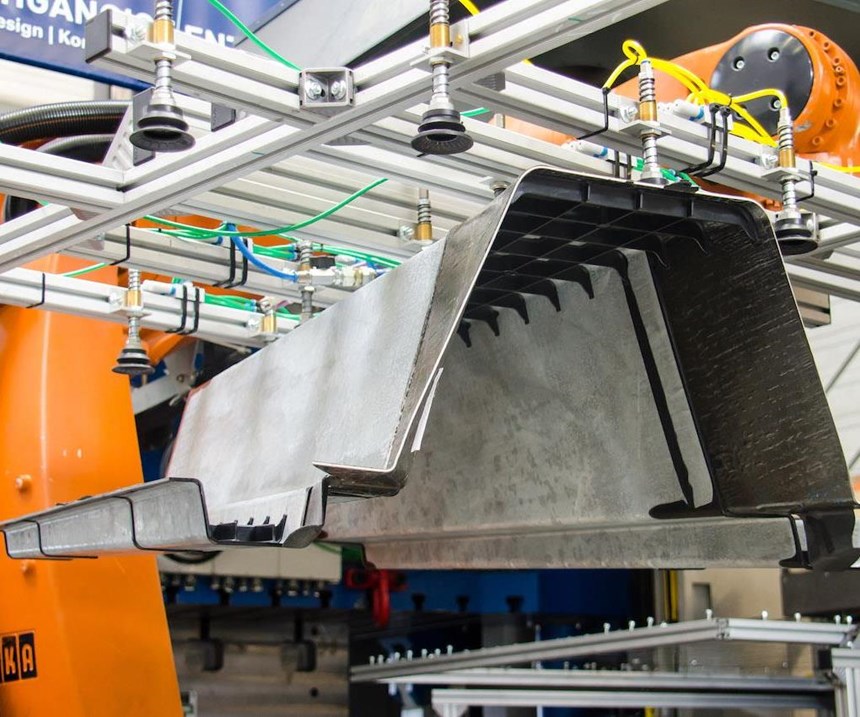KraussMaffei's new one-step forming and back injection for composites
KraussMaffei is working on the development of new hybrid materials and processes in collaboration with the Dresden University of Technology.
KraussMaffei Technologies GmbH (Munich, Germany) is working on the development of new hybrid materials and processes in collaboration with the Dresden University of Technology in Germany. Called the LEIKA research project, the new lab system is at the Institute for Lightweight Engineering and Polymer Technology. This system allows FRP-metal hybrid materials to be formed and back injected in one step.
The objective of the research project supported by the German Federal Ministry of Education and Research is to decrease the structural mass in electric vehicles by using innovative hybrid materials with a focus on processes ready for large-scale series production. "The new lab system at the Institute for Lightweight Engineering and Polymer Technology allows us to form and back-inject FRP-metal hybrid materials in one step. The resulting process and structure quality, together with the achieved cycle times of significantly less than two minutes, supports the potential of such hybridization on both the material and production end," says Martin Würtele, director of injection molding technology development at KraussMaffei.
Another great advantage of the new test system is its flexibility. KraussMaffei served as the system provider and has been closely involved in project engineering from the beginning. The new lab system is suited both for the manufacturing of components by injection molding and for the back injection of semifinished products. In addition, plastics can be used for compression in the mold or reinforcement for local areas in the component. This process sequence is implemented through the integration of a flat sheet die as well as a conveyor belt with an insertion robot. "The new test system lets us project a large number of incredibly varied processes on a single system. This lets us offer significant added value to our partners from the automotive industry," says Michael Krahl, project manager and person in charge of LEIKA at the Institute for Lightweight Engineering and Polymer Technology.
Flexibility is also a subject of major interest in the implementation of individual system components. This is why KraussMaffei designed a bolt-on unit of reduced height which is completely integrated with the production line including a press, infrared oven, robot and conveyor belt. The unit is capable of both injection molding and extrusion, portioning the injection volume in the process. As stated in the requirements specifications, up to five areas can be reinforced locally in one cycle. Another feature of note is the conveyor belt's full integration into the system to make it possible to deposit the individual portions of plastic. "The speed of the conveyor belt results directly from the process parameters, such as injection speed or throughput. This is a clear advantage for the Institute for Lightweight Engineering and Polymer Technology because there is no longer any need to set the conveyor belt manually beforehand and there is no discharged melt. In the event of a change in discharge speed, the conveyor belt speed adapts automatically and with deliberate control," says Würtele.
The software for the system has been completely rewritten. The MC6 from KraussMaffei acts as an open control system that handles the integration of the bolt-on and conveyor belt modules. In addition, it is also completely integrated into the production line electrically.
Another advantage is the high shot weight consistency of the associated SP 12000 injection unit with direct drive. The motors for plasticizing and injection are arranged in a series and directly flange-mounted on the screw, making it possible to prevent transverse forces opposing the flow of force. The result is very accurate metering and precise material discharge shot by shot.
Using the floor structure for electric vehicles as an example, the partners demonstrated the suitability of real-world implementation in series production for the innovative hybrid materials and their processes. For the center tunnel, the scientists combined metallic outer layers of steel with a core of CFRP. "The first test results are excellent. The mass is reduced by 25 percent compared to an all-metal lightweight construction solution. Simultaneously, it was possible to demonstrate comparable performance under the most important load conditions with regard to stiffness and crash situations for components with significantly lower mass," says Würtele.
Related Content
Porsche develops TABASKO method for lightweight vehicle series production
Patented carbon fiber-reinforced polypropylene tape-based process supports cost reduction, light weight and thinner walls without sacrificing rigidity.
Read MoreComposite Integration adds real-time resin degassing measuring to Ciject equipment
Ciject resin infusion and injection machinery now offers real-time resin degassing measurement technology that uses sensors and software to continuously monitor the state of resin during the degassing process.
Read MoreReinforce 3D, Bauer Hockey partner for CFIP-optimized sports equipment
Continuous carbon fiber injection process (CFIP) will achieve more durable, high-performance equipment for every athletic discipline.
Read MoreFraunhofer IGCV develops helicopter door shell using SMV composite
SMC-replacement material subjected to vario-thermal pressing cycle achieved a 1.2-millimeter-thick, complex-shaped door shell, demonstrating feasibility for future aerospace components.
Read MoreRead Next
Ceramic matrix composites: Faster, cheaper, higher temperature
New players proliferate, increasing CMC materials and manufacturing capacity, novel processes and automation to meet demand for higher part volumes and performance.
Read MoreCutting 100 pounds, certification time for the X-59 nose cone
Swift Engineering used HyperX software to remove 100 pounds from 38-foot graphite/epoxy cored nose cone for X-59 supersonic aircraft.
Read MoreNext-gen fan blades: Hybrid twin RTM, printed sensors, laser shock disassembly
MORPHO project demonstrates blade with 20% faster RTM cure cycle, uses AI-based monitoring for improved maintenance/life cycle management and proves laser shock disassembly for recycling.
Read More




























